Economics: Market Analysis, Equilibrium, and Resource Allocation
VerifiedAdded on 2020/04/29
|7
|1342
|416
Essay
AI Summary
This economics assignment provides an overview of market dynamics, focusing on the concepts of demand, supply, and equilibrium within a free market context. The assignment explains how the interaction of buyers and sellers determines market prices and quantities, illustrating these principles with a graphical representation of the equilibrium point. It discusses the law of demand and supply, the factors influencing them, and how the price mechanism allocates resources efficiently. The assignment further explores the concepts of consumer and producer surplus, highlighting how they are generated in a free market. It also examines the role of price signals in resource allocation, addressing the questions of what to produce, how to produce, and for whom to produce, thereby demonstrating the efficient functioning of the market. The assignment concludes by emphasizing the role of the market in maximizing welfare for both consumers and producers.
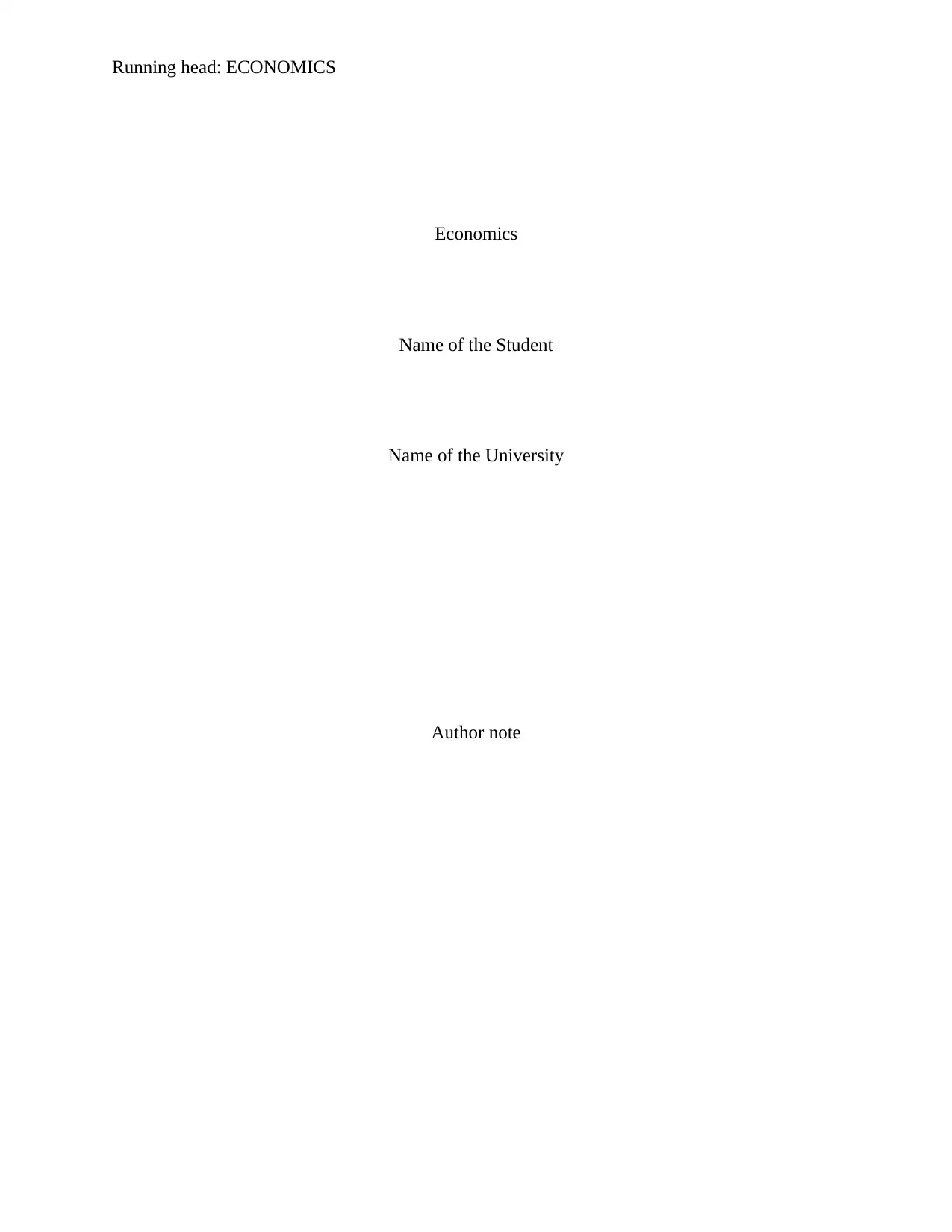
Running head: ECONOMICS
Economics
Name of the Student
Name of the University
Author note
Economics
Name of the Student
Name of the University
Author note
Paraphrase This Document
Need a fresh take? Get an instant paraphrase of this document with our AI Paraphraser
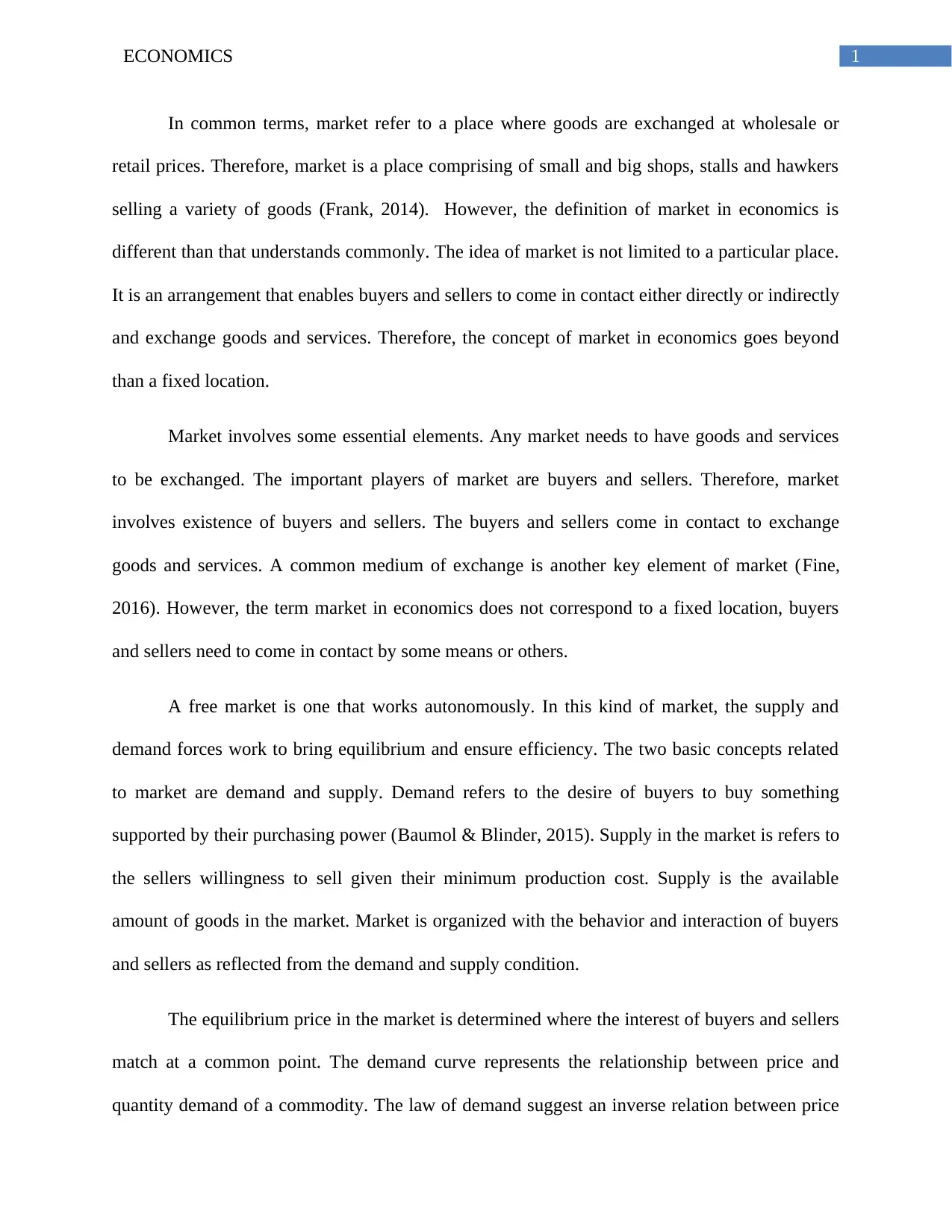
1ECONOMICS
In common terms, market refer to a place where goods are exchanged at wholesale or
retail prices. Therefore, market is a place comprising of small and big shops, stalls and hawkers
selling a variety of goods (Frank, 2014). However, the definition of market in economics is
different than that understands commonly. The idea of market is not limited to a particular place.
It is an arrangement that enables buyers and sellers to come in contact either directly or indirectly
and exchange goods and services. Therefore, the concept of market in economics goes beyond
than a fixed location.
Market involves some essential elements. Any market needs to have goods and services
to be exchanged. The important players of market are buyers and sellers. Therefore, market
involves existence of buyers and sellers. The buyers and sellers come in contact to exchange
goods and services. A common medium of exchange is another key element of market (Fine,
2016). However, the term market in economics does not correspond to a fixed location, buyers
and sellers need to come in contact by some means or others.
A free market is one that works autonomously. In this kind of market, the supply and
demand forces work to bring equilibrium and ensure efficiency. The two basic concepts related
to market are demand and supply. Demand refers to the desire of buyers to buy something
supported by their purchasing power (Baumol & Blinder, 2015). Supply in the market is refers to
the sellers willingness to sell given their minimum production cost. Supply is the available
amount of goods in the market. Market is organized with the behavior and interaction of buyers
and sellers as reflected from the demand and supply condition.
The equilibrium price in the market is determined where the interest of buyers and sellers
match at a common point. The demand curve represents the relationship between price and
quantity demand of a commodity. The law of demand suggest an inverse relation between price
In common terms, market refer to a place where goods are exchanged at wholesale or
retail prices. Therefore, market is a place comprising of small and big shops, stalls and hawkers
selling a variety of goods (Frank, 2014). However, the definition of market in economics is
different than that understands commonly. The idea of market is not limited to a particular place.
It is an arrangement that enables buyers and sellers to come in contact either directly or indirectly
and exchange goods and services. Therefore, the concept of market in economics goes beyond
than a fixed location.
Market involves some essential elements. Any market needs to have goods and services
to be exchanged. The important players of market are buyers and sellers. Therefore, market
involves existence of buyers and sellers. The buyers and sellers come in contact to exchange
goods and services. A common medium of exchange is another key element of market (Fine,
2016). However, the term market in economics does not correspond to a fixed location, buyers
and sellers need to come in contact by some means or others.
A free market is one that works autonomously. In this kind of market, the supply and
demand forces work to bring equilibrium and ensure efficiency. The two basic concepts related
to market are demand and supply. Demand refers to the desire of buyers to buy something
supported by their purchasing power (Baumol & Blinder, 2015). Supply in the market is refers to
the sellers willingness to sell given their minimum production cost. Supply is the available
amount of goods in the market. Market is organized with the behavior and interaction of buyers
and sellers as reflected from the demand and supply condition.
The equilibrium price in the market is determined where the interest of buyers and sellers
match at a common point. The demand curve represents the relationship between price and
quantity demand of a commodity. The law of demand suggest an inverse relation between price
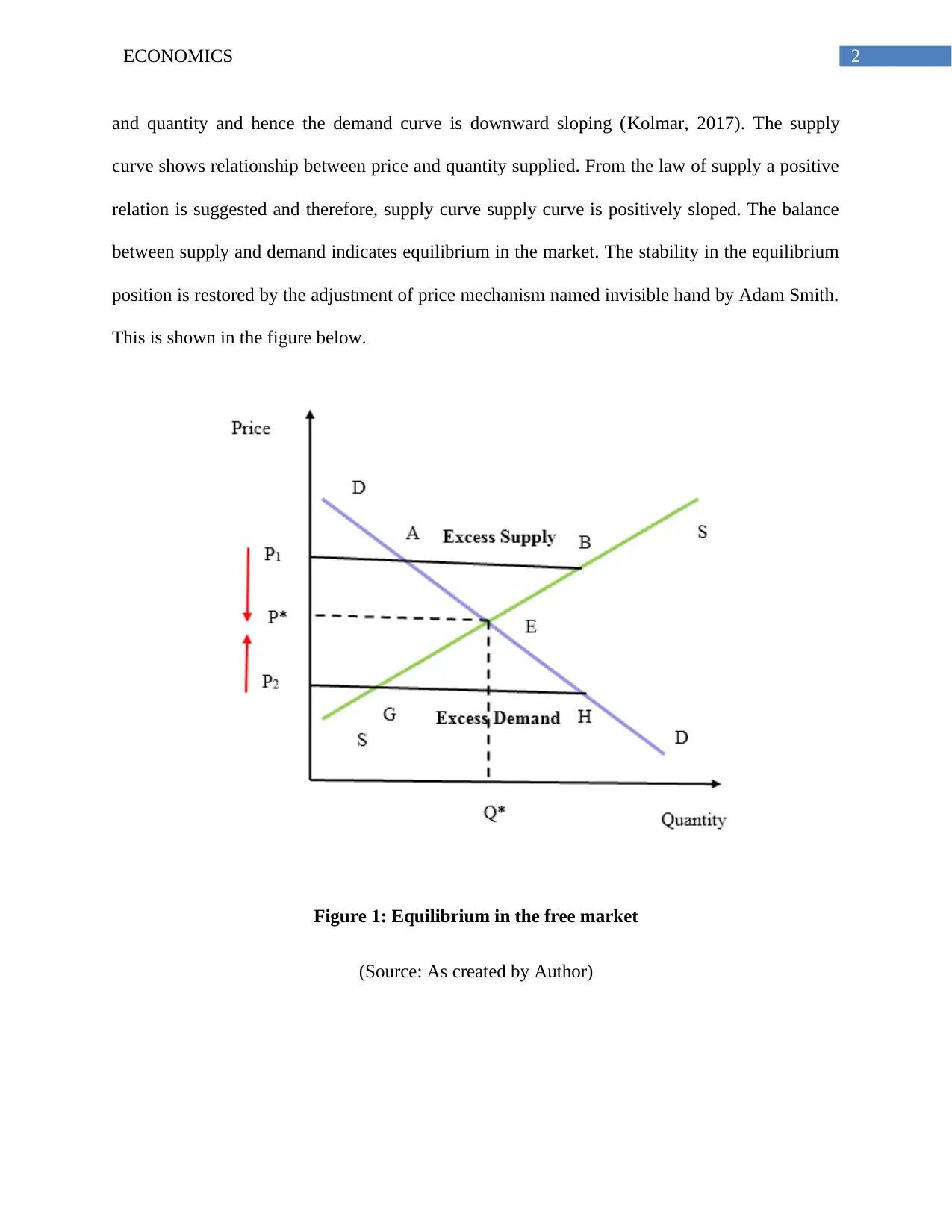
2ECONOMICS
and quantity and hence the demand curve is downward sloping (Kolmar, 2017). The supply
curve shows relationship between price and quantity supplied. From the law of supply a positive
relation is suggested and therefore, supply curve supply curve is positively sloped. The balance
between supply and demand indicates equilibrium in the market. The stability in the equilibrium
position is restored by the adjustment of price mechanism named invisible hand by Adam Smith.
This is shown in the figure below.
Figure 1: Equilibrium in the free market
(Source: As created by Author)
and quantity and hence the demand curve is downward sloping (Kolmar, 2017). The supply
curve shows relationship between price and quantity supplied. From the law of supply a positive
relation is suggested and therefore, supply curve supply curve is positively sloped. The balance
between supply and demand indicates equilibrium in the market. The stability in the equilibrium
position is restored by the adjustment of price mechanism named invisible hand by Adam Smith.
This is shown in the figure below.
Figure 1: Equilibrium in the free market
(Source: As created by Author)
⊘ This is a preview!⊘
Do you want full access?
Subscribe today to unlock all pages.

Trusted by 1+ million students worldwide
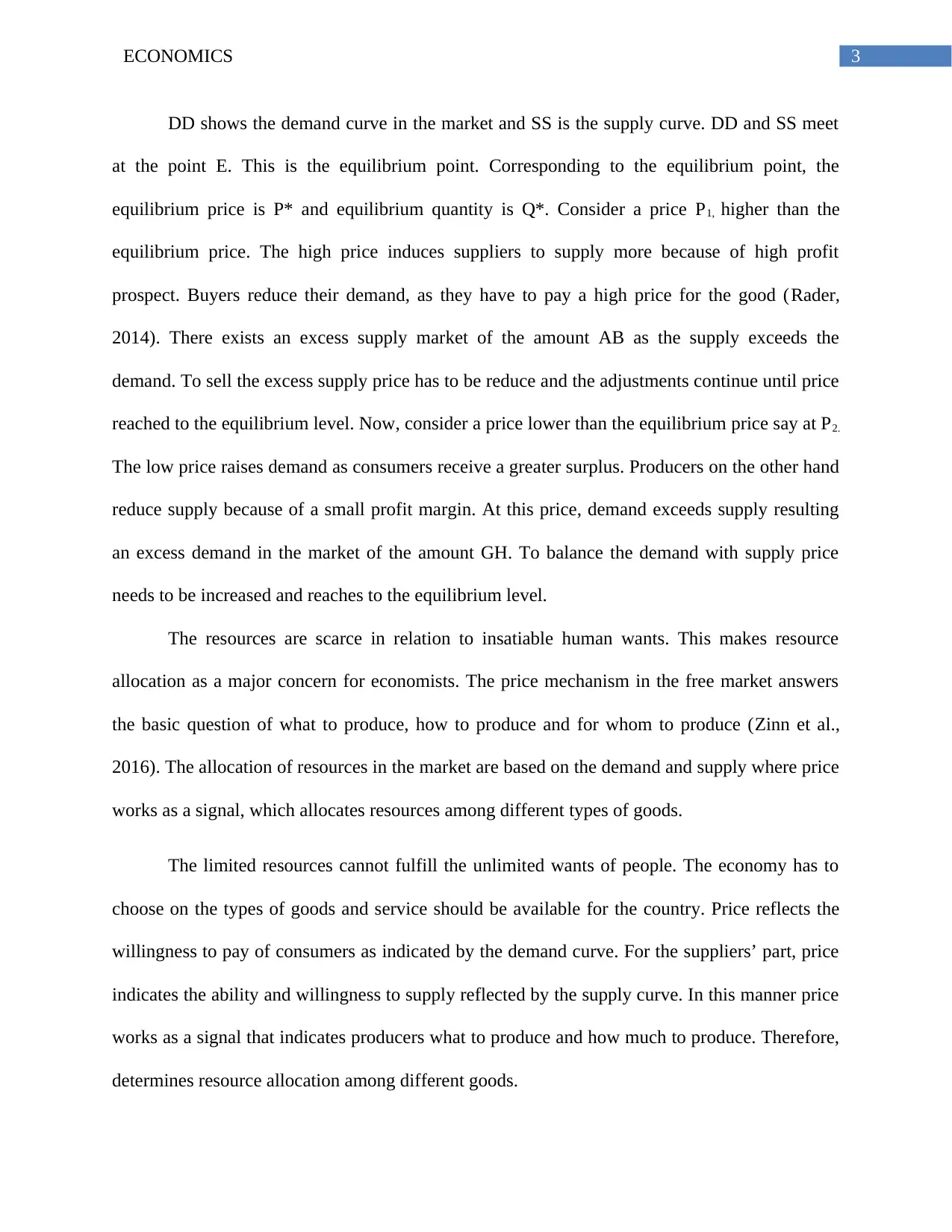
3ECONOMICS
DD shows the demand curve in the market and SS is the supply curve. DD and SS meet
at the point E. This is the equilibrium point. Corresponding to the equilibrium point, the
equilibrium price is P* and equilibrium quantity is Q*. Consider a price P1, higher than the
equilibrium price. The high price induces suppliers to supply more because of high profit
prospect. Buyers reduce their demand, as they have to pay a high price for the good (Rader,
2014). There exists an excess supply market of the amount AB as the supply exceeds the
demand. To sell the excess supply price has to be reduce and the adjustments continue until price
reached to the equilibrium level. Now, consider a price lower than the equilibrium price say at P2.
The low price raises demand as consumers receive a greater surplus. Producers on the other hand
reduce supply because of a small profit margin. At this price, demand exceeds supply resulting
an excess demand in the market of the amount GH. To balance the demand with supply price
needs to be increased and reaches to the equilibrium level.
The resources are scarce in relation to insatiable human wants. This makes resource
allocation as a major concern for economists. The price mechanism in the free market answers
the basic question of what to produce, how to produce and for whom to produce (Zinn et al.,
2016). The allocation of resources in the market are based on the demand and supply where price
works as a signal, which allocates resources among different types of goods.
The limited resources cannot fulfill the unlimited wants of people. The economy has to
choose on the types of goods and service should be available for the country. Price reflects the
willingness to pay of consumers as indicated by the demand curve. For the suppliers’ part, price
indicates the ability and willingness to supply reflected by the supply curve. In this manner price
works as a signal that indicates producers what to produce and how much to produce. Therefore,
determines resource allocation among different goods.
DD shows the demand curve in the market and SS is the supply curve. DD and SS meet
at the point E. This is the equilibrium point. Corresponding to the equilibrium point, the
equilibrium price is P* and equilibrium quantity is Q*. Consider a price P1, higher than the
equilibrium price. The high price induces suppliers to supply more because of high profit
prospect. Buyers reduce their demand, as they have to pay a high price for the good (Rader,
2014). There exists an excess supply market of the amount AB as the supply exceeds the
demand. To sell the excess supply price has to be reduce and the adjustments continue until price
reached to the equilibrium level. Now, consider a price lower than the equilibrium price say at P2.
The low price raises demand as consumers receive a greater surplus. Producers on the other hand
reduce supply because of a small profit margin. At this price, demand exceeds supply resulting
an excess demand in the market of the amount GH. To balance the demand with supply price
needs to be increased and reaches to the equilibrium level.
The resources are scarce in relation to insatiable human wants. This makes resource
allocation as a major concern for economists. The price mechanism in the free market answers
the basic question of what to produce, how to produce and for whom to produce (Zinn et al.,
2016). The allocation of resources in the market are based on the demand and supply where price
works as a signal, which allocates resources among different types of goods.
The limited resources cannot fulfill the unlimited wants of people. The economy has to
choose on the types of goods and service should be available for the country. Price reflects the
willingness to pay of consumers as indicated by the demand curve. For the suppliers’ part, price
indicates the ability and willingness to supply reflected by the supply curve. In this manner price
works as a signal that indicates producers what to produce and how much to produce. Therefore,
determines resource allocation among different goods.
Paraphrase This Document
Need a fresh take? Get an instant paraphrase of this document with our AI Paraphraser
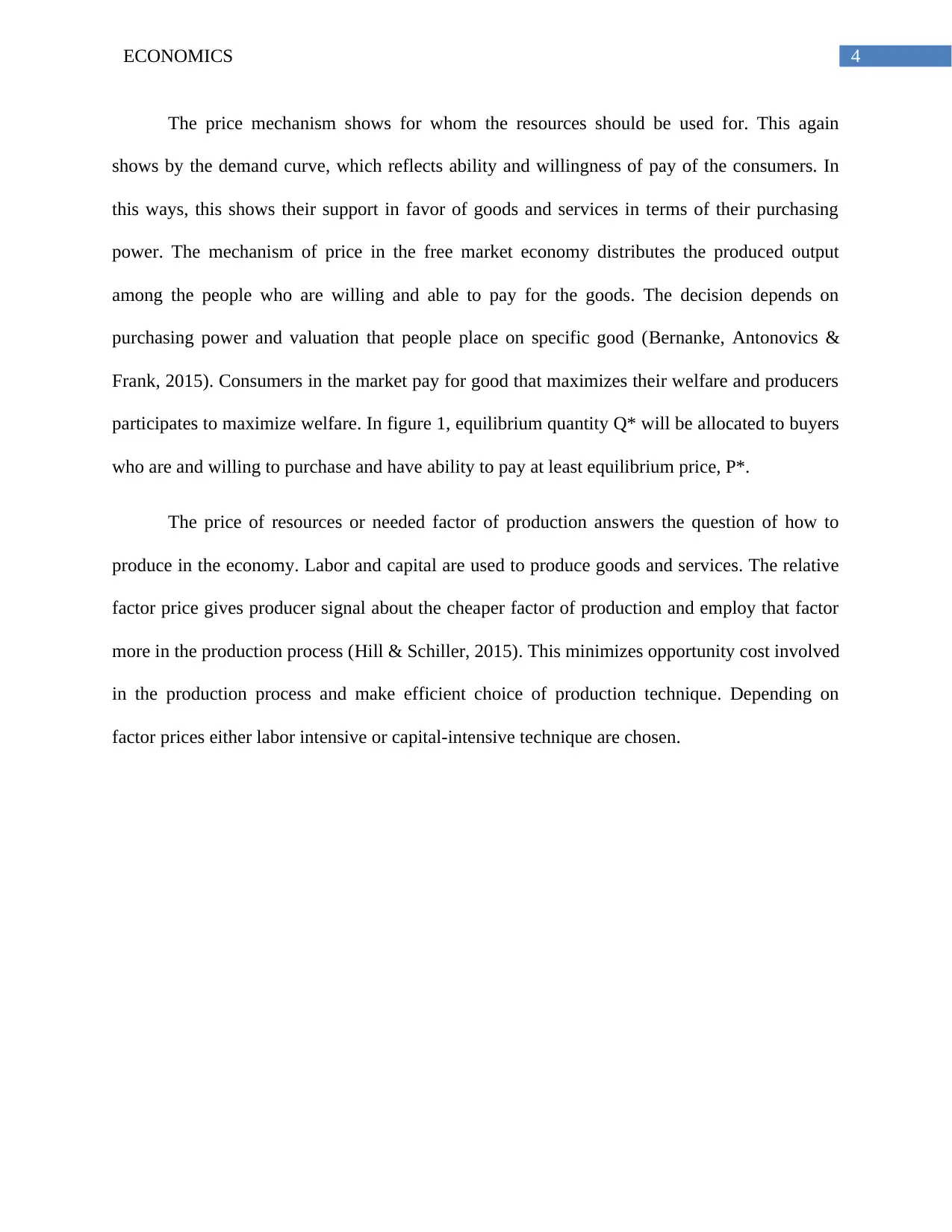
4ECONOMICS
The price mechanism shows for whom the resources should be used for. This again
shows by the demand curve, which reflects ability and willingness of pay of the consumers. In
this ways, this shows their support in favor of goods and services in terms of their purchasing
power. The mechanism of price in the free market economy distributes the produced output
among the people who are willing and able to pay for the goods. The decision depends on
purchasing power and valuation that people place on specific good (Bernanke, Antonovics &
Frank, 2015). Consumers in the market pay for good that maximizes their welfare and producers
participates to maximize welfare. In figure 1, equilibrium quantity Q* will be allocated to buyers
who are and willing to purchase and have ability to pay at least equilibrium price, P*.
The price of resources or needed factor of production answers the question of how to
produce in the economy. Labor and capital are used to produce goods and services. The relative
factor price gives producer signal about the cheaper factor of production and employ that factor
more in the production process (Hill & Schiller, 2015). This minimizes opportunity cost involved
in the production process and make efficient choice of production technique. Depending on
factor prices either labor intensive or capital-intensive technique are chosen.
The price mechanism shows for whom the resources should be used for. This again
shows by the demand curve, which reflects ability and willingness of pay of the consumers. In
this ways, this shows their support in favor of goods and services in terms of their purchasing
power. The mechanism of price in the free market economy distributes the produced output
among the people who are willing and able to pay for the goods. The decision depends on
purchasing power and valuation that people place on specific good (Bernanke, Antonovics &
Frank, 2015). Consumers in the market pay for good that maximizes their welfare and producers
participates to maximize welfare. In figure 1, equilibrium quantity Q* will be allocated to buyers
who are and willing to purchase and have ability to pay at least equilibrium price, P*.
The price of resources or needed factor of production answers the question of how to
produce in the economy. Labor and capital are used to produce goods and services. The relative
factor price gives producer signal about the cheaper factor of production and employ that factor
more in the production process (Hill & Schiller, 2015). This minimizes opportunity cost involved
in the production process and make efficient choice of production technique. Depending on
factor prices either labor intensive or capital-intensive technique are chosen.
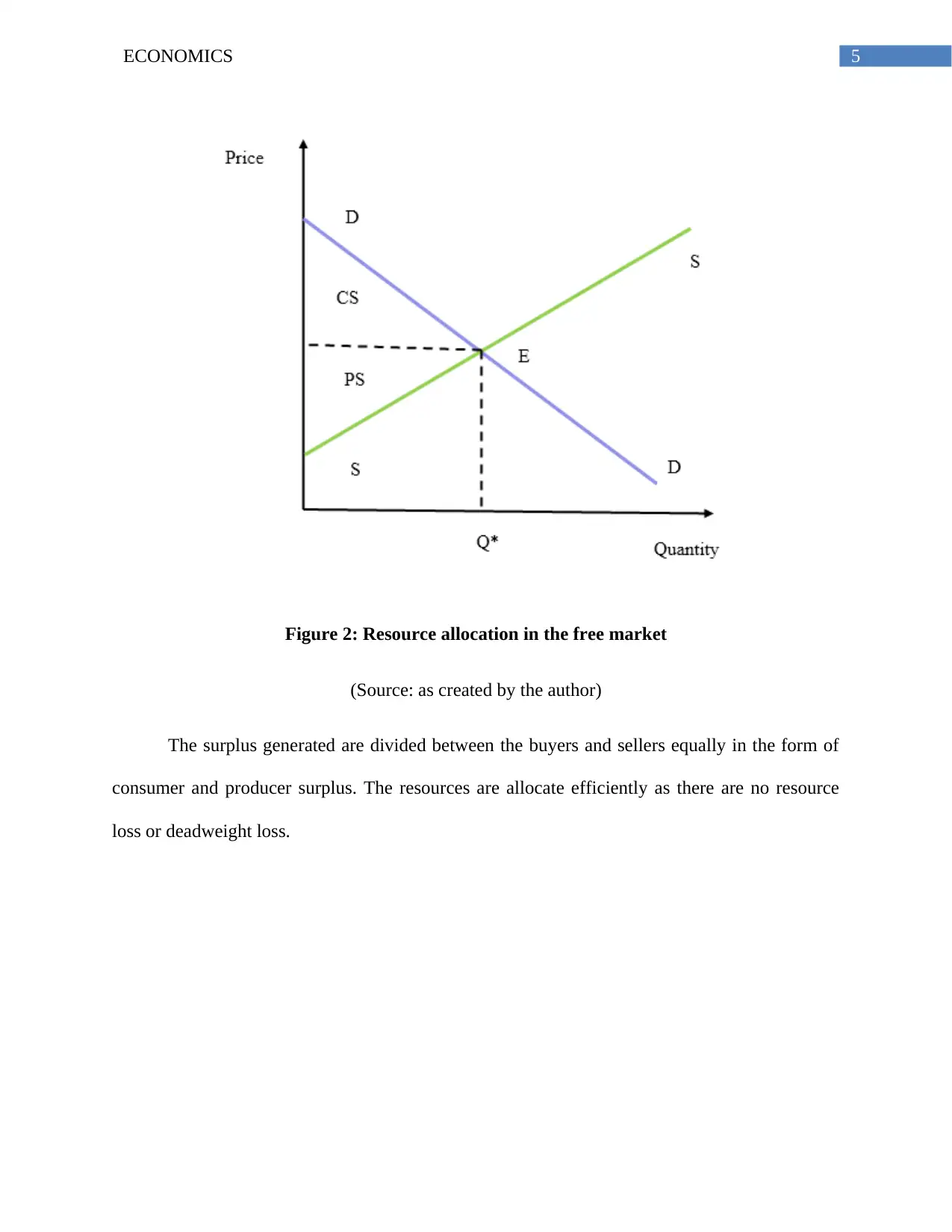
5ECONOMICS
Figure 2: Resource allocation in the free market
(Source: as created by the author)
The surplus generated are divided between the buyers and sellers equally in the form of
consumer and producer surplus. The resources are allocate efficiently as there are no resource
loss or deadweight loss.
Figure 2: Resource allocation in the free market
(Source: as created by the author)
The surplus generated are divided between the buyers and sellers equally in the form of
consumer and producer surplus. The resources are allocate efficiently as there are no resource
loss or deadweight loss.
⊘ This is a preview!⊘
Do you want full access?
Subscribe today to unlock all pages.

Trusted by 1+ million students worldwide
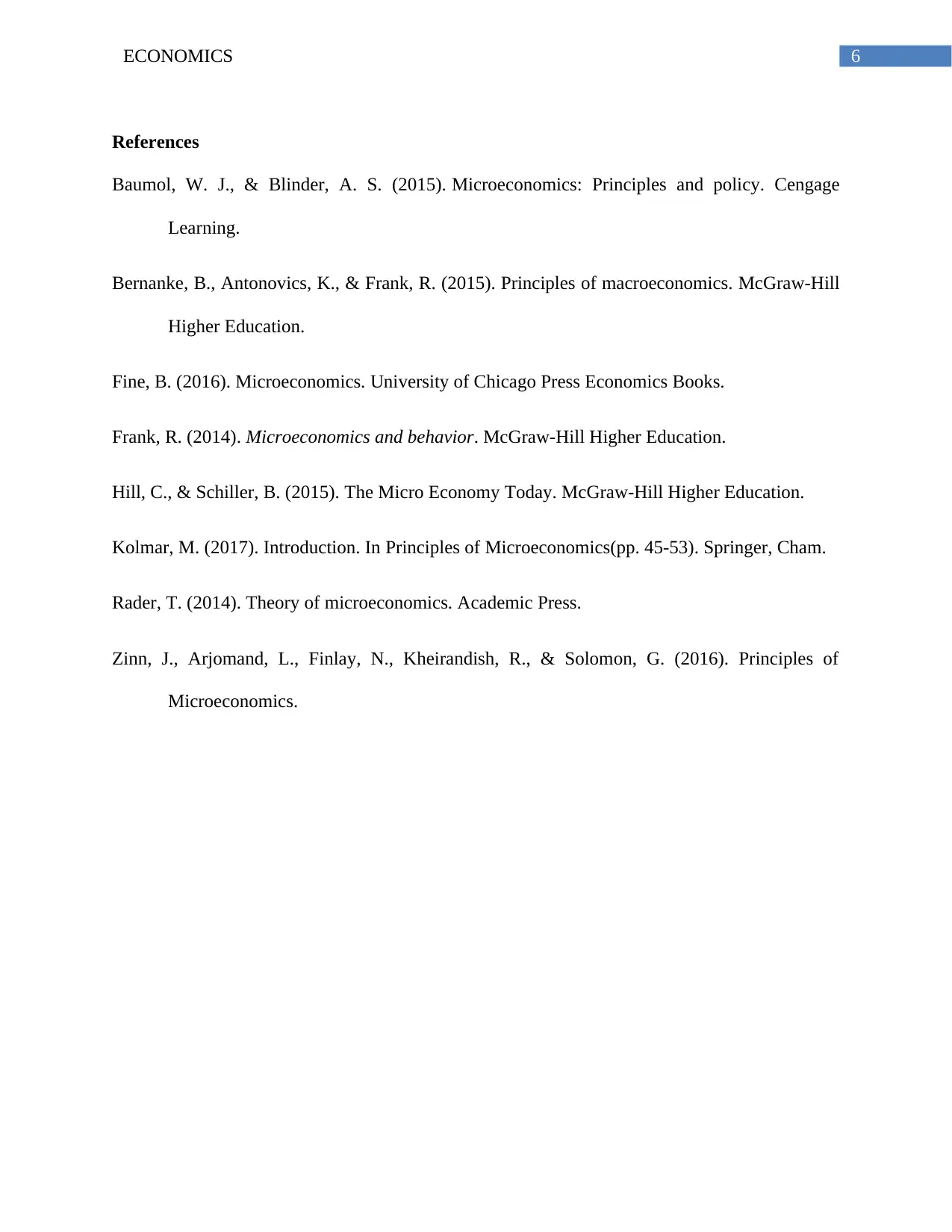
6ECONOMICS
References
Baumol, W. J., & Blinder, A. S. (2015). Microeconomics: Principles and policy. Cengage
Learning.
Bernanke, B., Antonovics, K., & Frank, R. (2015). Principles of macroeconomics. McGraw-Hill
Higher Education.
Fine, B. (2016). Microeconomics. University of Chicago Press Economics Books.
Frank, R. (2014). Microeconomics and behavior. McGraw-Hill Higher Education.
Hill, C., & Schiller, B. (2015). The Micro Economy Today. McGraw-Hill Higher Education.
Kolmar, M. (2017). Introduction. In Principles of Microeconomics(pp. 45-53). Springer, Cham.
Rader, T. (2014). Theory of microeconomics. Academic Press.
Zinn, J., Arjomand, L., Finlay, N., Kheirandish, R., & Solomon, G. (2016). Principles of
Microeconomics.
References
Baumol, W. J., & Blinder, A. S. (2015). Microeconomics: Principles and policy. Cengage
Learning.
Bernanke, B., Antonovics, K., & Frank, R. (2015). Principles of macroeconomics. McGraw-Hill
Higher Education.
Fine, B. (2016). Microeconomics. University of Chicago Press Economics Books.
Frank, R. (2014). Microeconomics and behavior. McGraw-Hill Higher Education.
Hill, C., & Schiller, B. (2015). The Micro Economy Today. McGraw-Hill Higher Education.
Kolmar, M. (2017). Introduction. In Principles of Microeconomics(pp. 45-53). Springer, Cham.
Rader, T. (2014). Theory of microeconomics. Academic Press.
Zinn, J., Arjomand, L., Finlay, N., Kheirandish, R., & Solomon, G. (2016). Principles of
Microeconomics.
1 out of 7
Related Documents
Your All-in-One AI-Powered Toolkit for Academic Success.
+13062052269
info@desklib.com
Available 24*7 on WhatsApp / Email
![[object Object]](/_next/static/media/star-bottom.7253800d.svg)
Unlock your academic potential
Copyright © 2020–2025 A2Z Services. All Rights Reserved. Developed and managed by ZUCOL.





